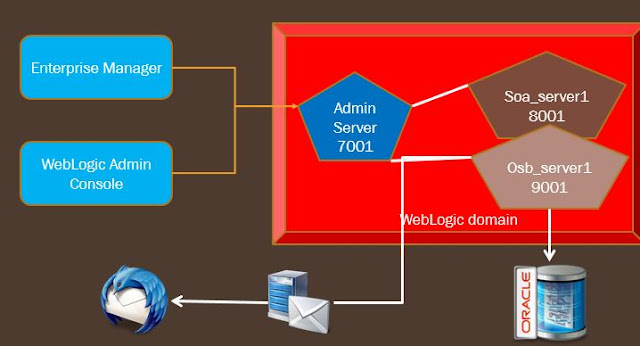Oracle SOA Platform Overview
Introduction to Oracle SOA Administration
Latest version from Oracle we can see Oracle SOA 12c that is in the year 2014 or 2015. As every new release there are many challenges expected for the existing projects who already running with Oracle SOA 11g. For our learning purpose better exercise on 11g first then migrate to 12c would give more clearity on every component why we are using this way!
Download Links: downloads.oracle.com
You can download 3GB size .zip file for 12c which is more focused on cloud specific features. I like the one step to go - one file to download in 12c. Well most of the projects initiated with 11g and the stable version of Oracle SOA Suite is available as 11g. So, ready for any thing at the moment :) You can select previous version that is 11g from the download bottom link contains here
- ofm_rcu_linux_11.1.1.7.0_64_disk1_1of1.zip
- ofm_soa_generic_11.1.1.7.0_disk1_1of2.zip
- ofm_soa_generic_11.1.1.7.0_disk1_2of2.zip
Click on the include features
Prerequsites SOA Installation
SOA Suite 2 parts
OSB [optional]
1. DB XE
Windows XE 64bit,32bit available now.
DB xe is for personal learnings, Complete oracle db is required for realtime implementation.
2. Oracle SOA Suite
adapter Seibel, Peoplesoft, iflex applications can connect with SOA Layer.
Middleware
Content service,
Oracle focused on Infrastructure
TIBCO is competitor - Middleware
Websphere Process Server - separate adapters
Why we have to use SOA?
1. Agility
2. Visibility
3. Efficiencies
Composites are created and sold to others. We are going to restarunt. You will be occupied a table. If the server taking you inputs from you and using a touch pad and send to kitchen services. Two SOA service, once this done the automatically bill will be generated. That is the 3rd service. This is called internal integration. When you use the credit card. that is external service that is payment gateway.
ShoppingCart example.
We can prepare the project that will prepare for online purchase.
Hairball integration architecture it is tightly coupled. Every composite is running from years. before the SOA it was a mess.
Many people working on application is such a long the complete architecture is too difficulty.
Process gaps - this is integrations architecture is complex.
SOA suite you can track it with EM console. It is easy to find what happend in where in the application side.
Example: stock market what is happening in the site.
Last of month you did transaction it is not completed. how to trace these? Solution is provided by SOA. SOA will give you the date ranges, transactions that happened on that date. Which flow failed, rejected or issue. A transactions failed in 6 months back the customer report is valid then we can reprocessed. If your application is Bank they maintain 6 months data in the active state. In some other businesses it will be every month we need to purge.
In the migrations you might get RCU upgrade.
Workflow automation - BPM after SOA in use it is separate composite. Loan service if you in need kitchen something then we can directly can go there and pick, instead of
navigation of
SOA Platform components in short description -
BAM - Monitoring and Reporting tool
EM - EM is with Fusion Middleware Infrastructure monitoring
Mediator and OSB looks like same. Both have similar functionality. Mediator work in between with in the organization components. OSB works when we have external services communications.
OSB - Integration
For example if you consider two banks -- HDFC, ICICI common Loan processing system. I need a loan that is best rates provided. If user is set a limitation <10% for this condition satisfied by HDFC work flow forwards it.
Service virtualization input is common the output would be in differs. OSB will understand the requirements and hand over/routing services to right destinations. OSB also having business logic will be there.



Comments
Post a Comment